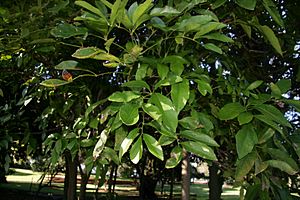Carnarvonia facts for kids
Quick facts for kids Carnarvonia |
|
|---|---|
 |
|
| Foliage | |
| Scientific classification | |
| Genus: |
Carnarvonia
|
| Species: |
araliifolia
|
Carnarvonia is a group of flowering plants that has only one known type of plant. This plant is often called red oak or red silky oak. It belongs to a plant family called Proteaceae.
The single species, named Carnarvonia araliifolia, grows into very tall trees. These trees can reach heights of 30 m (100 ft) or even more. They naturally grow only in the Wet Tropics rainforests region. This special area is located in north-eastern Queensland, Australia.
There are two main types, or varieties, of Carnarvonia araliifolia. They are called C. araliifolia var. araliifolia and C. araliifolia var. montana. Both types share the common names red oak or red silky oak.
The C. araliifolia var. araliifolia type grows in lower areas. You can find it from about 50 to 1,000 m (160 to 3,280 ft) above sea level. These trees grow biggest on rich, fertile soils that come from basalt rock.
The C. araliifolia var. montana type prefers higher places. It grows in the uplands, tablelands, and mountains. You can find it from about 650 to 1,300 m (2,130 to 4,270 ft) high. Its name, montana, means "of the mountains," which fits where it grows.
Contents
Discovering and Naming Carnarvonia
Who Named This Tree?
In 1867, a botanist named Ferdinand von Mueller officially named this plant. He chose the name Carnarvonia to honor Henry Herbert, 4th Earl of Carnarvon.
Different Types of Carnarvonia
Later, in 1995, another botanist named Bernie Hyland studied the plant more closely. He updated its description and identified the two different varieties we know today.
How Botanists Classify It
Scientists use phylogenetics to study how plants are related. These studies show that Carnarvonia araliifolia is a very old type of plant. It branched off early from the main Proteaceae family tree. This means it still has some ancient features.
Botanists place this species in a group called Grevilleoideae. This is because its tiny first leaves, called cotyledons, have small ear-like parts called auricles. All other plants in the Grevilleoideae group have these auricles, but other Proteaceae plants outside this group do not.
What Does Carnarvonia Look Like?
Size and Trunk
C. araliifolia grows into a very tall tree in its natural rainforest home. Its trunk is a pale grey color. The base of the trunk has rounded parts called buttresses, which can look like an elephant's foot.
Leaves and Flowers
The leaves of the tree are made up of several smaller leaflets, making them "compound" leaves. They can be up to 35 cm (14 in) long. The leaves are arranged one after another along the stem in an alternating pattern.
From November to May, the tree produces white or cream-colored flowers. These flowers grow in large, branched clusters called inflorescences.
Fruits and Seeds
After flowering, the tree grows woody fruits. These fruits ripen between July and March. Each fruit holds one or two winged seeds inside. Birds like sulphur-crested cockatoos enjoy eating these seeds.

